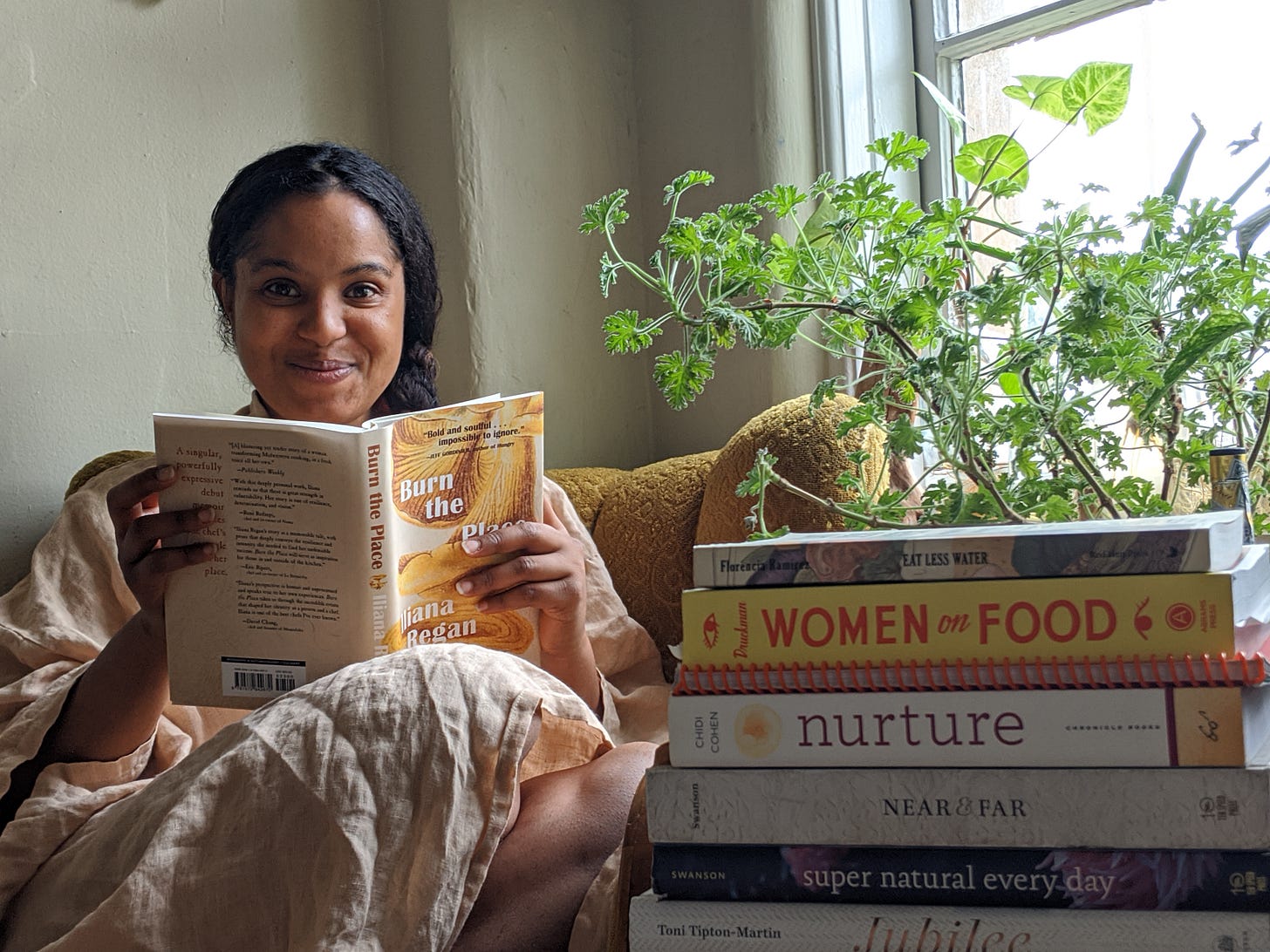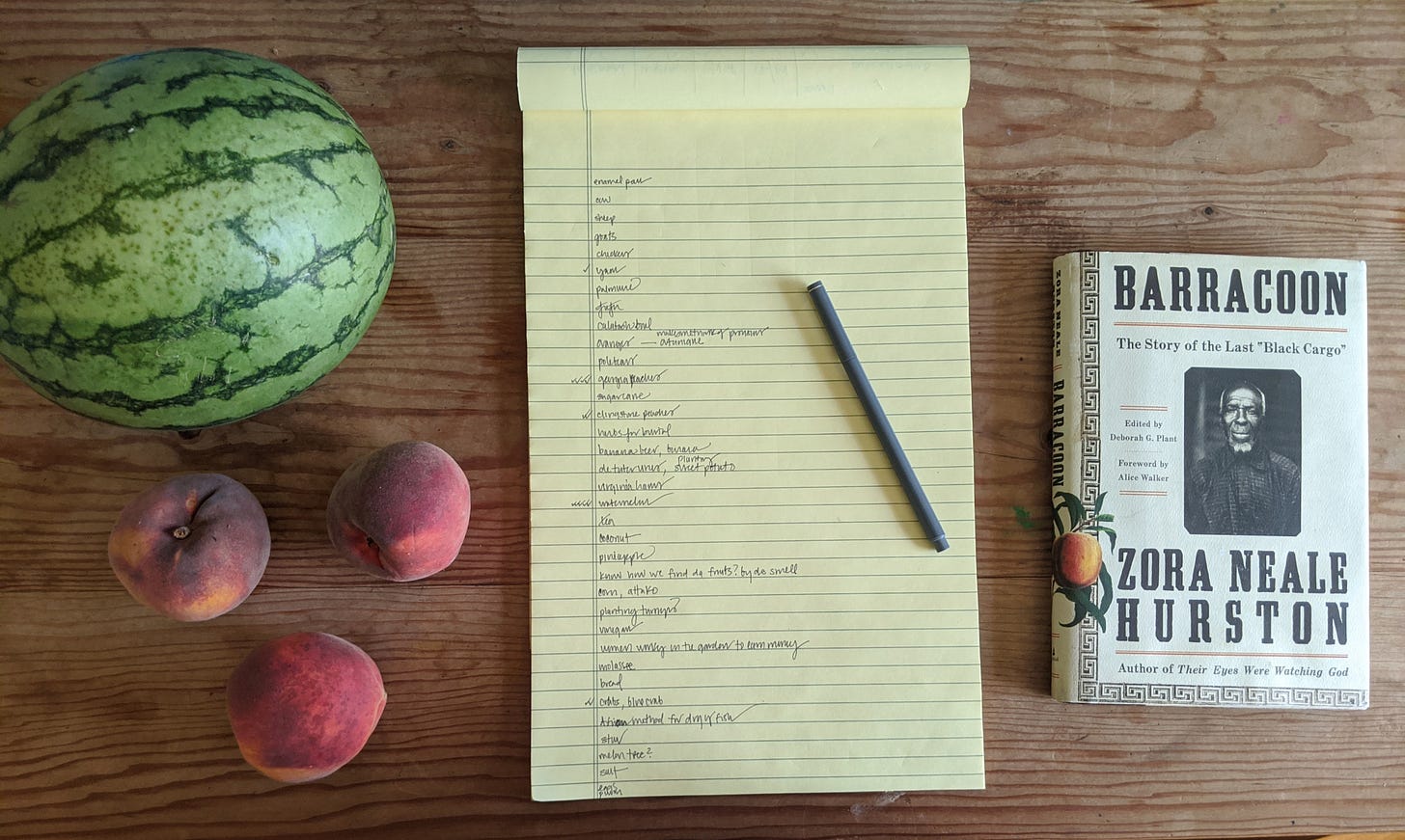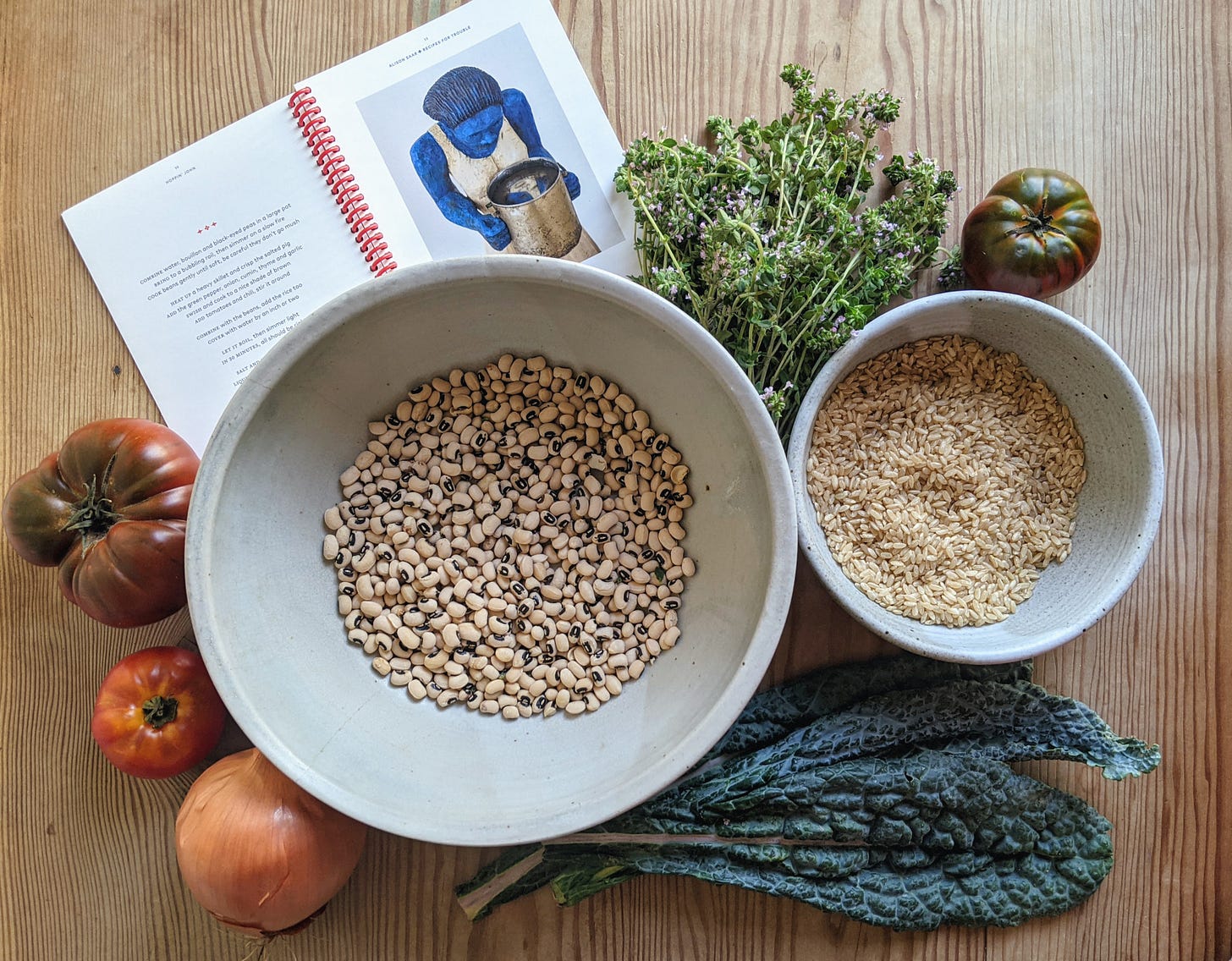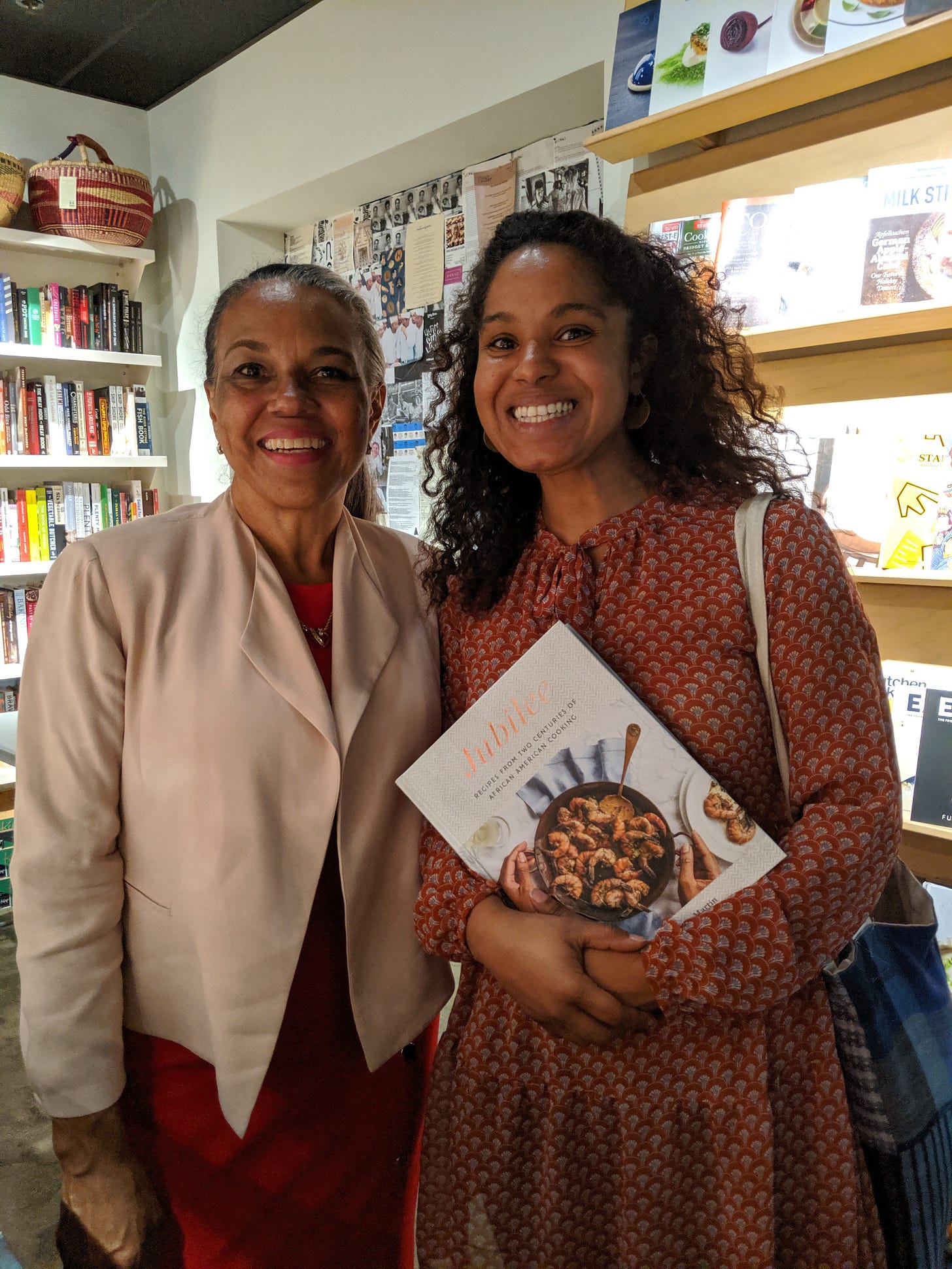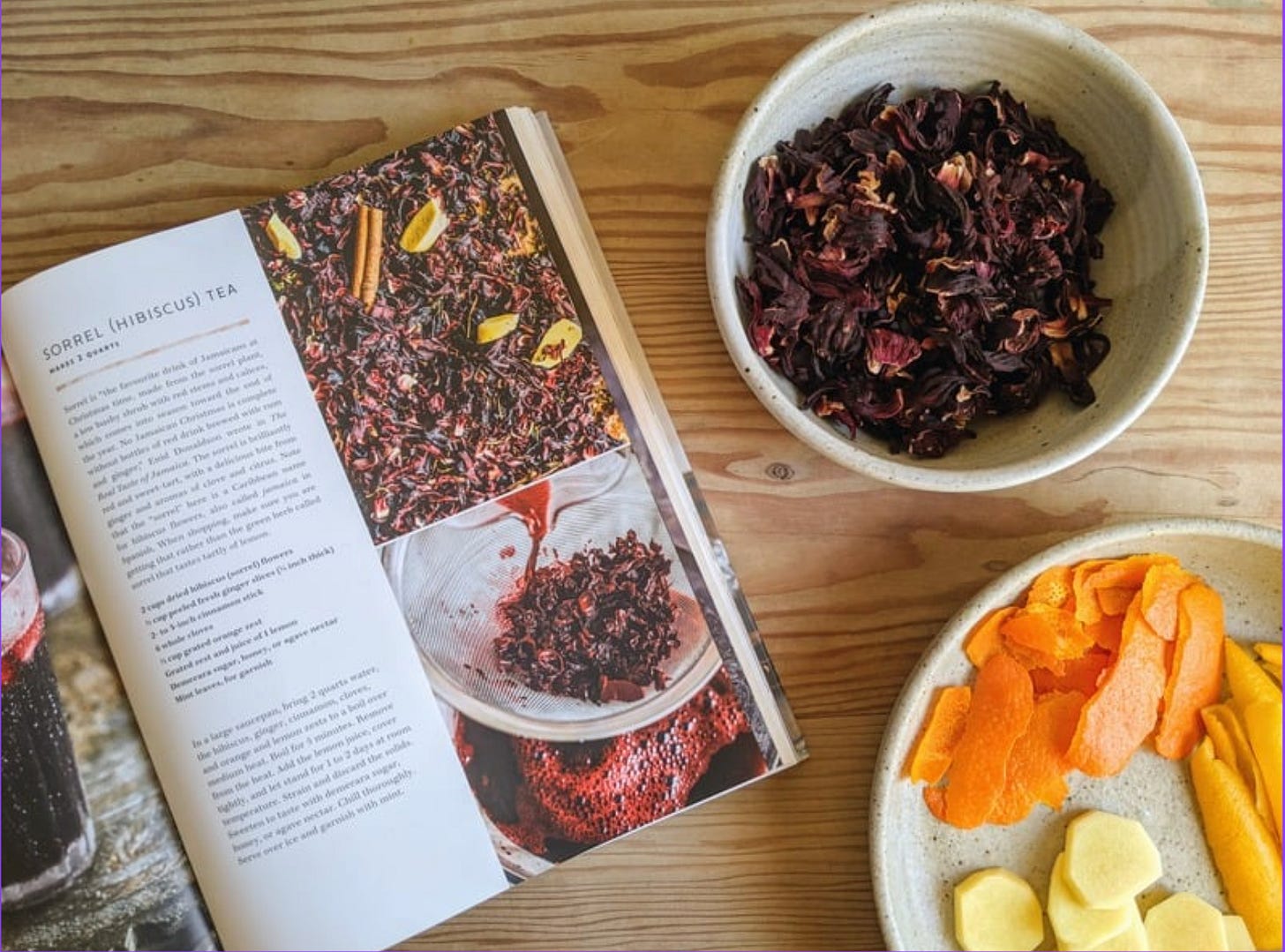Five years ago, during the pandemic, when we were all finding new ways to connect and learn together, B. Evy-Marie Yarde, Narrative Food’s creative director at the time, created a beautifully researched mealplan with recipes to celebrate Juneteenth.
B. Evy-Marie brought her expertise as a produce buyer and her commitment to local food systems to everything we did, always making it beautiful in the process. Working together as frontline workers during those challenging times, she developed these materials for us when people were home, engaged, and ready to dive deep into food history and its connections to justice. I am forever grateful for the love and grace she invested into all the materials we created, particularly during this challenging time.
The recipes and background you'll find here come from that 2020 work, when B. Evy-Marie's research and writing helped us understand how "holding space for celebration while distressed is an act of resistance."
Why Reprint This Now?
As we wrote in 2020: "We hope that you will be inspired to learn more about Juneteenth and use food as a tool to dig into this country's history to excavate materials for a clearer vision for the future."
That need for education and understanding hasn't diminished. If anything, having these conversations in rural Maine - through the lens of food and seasonal ingredients - feels more important than ever. Juneteenth has been a federal holiday since 2021, but many of us are still learning about its food traditions and cultural significance. This is a chance to understand the holiday through recipes and stories. We will be popping open our Narrative Food doors on Friday June 13th, during the Stonington farmer’s market from 10 AM-12 noon, with plantains, sumac, polenta, and hibiscus flowers, and recipe cards from this mealplan, so our Deer Isle community can also explore some of these foods and recipes inspired by artist Alison Saar's cookbooklet Recipes for Trouble, which was part of a body of work she created for L.A. Louver at Frieze Los Angeles 2020. We are thrilled to have an excuse to showcase this entire project once again.
Freedom & Family: A note from B. Evy-Marie
This week's menu, while inspired by Alison Saar's Recipes for Trouble, is a preamble to the celebration of Juneteenth, which is celebrated on June 19th to commemorate the emancipation of enslaved people in the US. The holiday was first celebrated in Texas, where on that date in 1865, slaves were finally declared free, three years after the 1862 Emancipation Proclamation.
This week gives us time to pause and think about what this history means to us as individual households and as a community, how things have changed since the previous Juneteenth, and what our future looks like.
To be honest, I didn't grow up celebrating Juneteenth and only learned about it as an adult in the last decade. While previously ashamed of not knowing about this important part of history, I instead have learned to be grateful for opportunities to share what it means to me – a time to reflect on freedom and family. I am endlessly grateful for Dr. Jessica B. Harris, Stephen Satterfield, Oriana Koren, Michael W. Twitty, and more – their work has opened eyes, hearts, and minds to histories and food narratives that were previously overlooked. My hope is that this week's menu inspires you to take time to peruse our suggested reading list and invite them to your table and onto your shelves.
Suggested Reading List
On Juneteenth, Annette Gordon-Reid
High on the Hog, Dr. Jessica B. Harris
The Cooking Gene, Michael W. Twitty
We are Each Other's Harvest Natalie Baszile
Voyage of The Sable Venus, Robin Coste Lewis
RECIPES BELOW FOR:
Sorrel Tea
Southern Succotash
Hoppin' John Grain Bowl with Mustard Green Salad & Heirloom Tomatoes
Fried Chicken
Collard Salad
Black Skillet Cornbread
Sweet Potato Pie
Sorrel Tea
WHY SORREL TEA FOR JUNETEENTH?
"The practice of eating red foods—red cake, barbecue, punch and fruit– may owe its existence to the enslaved Yoruba and Kongo brought to Texas in the 19th century. For both of these cultures the color red is the embodiment of spiritual power and transformation." – from Michael W. Twitty's Afroculinaria essay "Terroir Noire: African American Foodways in Slavery, Texas"
Recipe Adapted from: Jubilee by Toni Tipton-Martin
Ingredients:
2 cups dried Hibiscus (sorrel) flowers
1/3 cup peeled fresh ginger, thinly sliced
1/4 cup grated citrus zest (orange and lime has been our favorite combination)
grated zest and juice of a lemon
mint leaves, for garnish
watermelon slices (optional)
a cinnamon stick
sugar or honey
spices, to taste - the original recipe calls for cloves, but we enjoyed it with black pepper and cardamom
Instructions:
In a large saucepan, bring 2 quarts of water, the hibiscus, ginger, spices, and zest to a boil. Boil for 5 minutes. Add the lemon juice, cover tightly, and let stand for 1-2 days at room temperature.
Strain and discard the solids (or use to infuse vodka if you're feeling jazzy). Sweeten to taste with sugar or honey. Chill. Serve over ice and garnish with mint and serve with watermelon.

“VARIOUS TYPES OF SUCCOTASH WERE EATEN BY TRIBES ON THE EASTERN SEABOARD. THEY WERE LATER ADOPTED AND ADAPTED BY AFRICAN AMERICANS TO INCLUDE SUCH INGREDIENTS AS OKRA*, TOMATOES, AND EVEN BLACK-EYED PEAS.” – FROM HIGH ON THE HOG BY JESSICA B. HARRIS
Summer Southern Succotash
Adapted from: High on the Hog by Jessica B. Harris
Ingredients:
3-4 ripe heirloom tomatoes, seeded* and
coarsely chopped
2 cups fresh corn kernels
1 lb green beans, tops and tails trimmed,
cut into bite-sized pieces
cooked Andouile sausages (opt.)
1 ½ cups water
Salt and pepper, to taste
1 habanero or other chili, pricked with a knife (optional)
*Notes: if okra is unavailable, try substituting with green beans for a lovely tender crunch. Tomatoes - To seed the tomatoes, just cut them in half horizontally and squeeze the cut side into a bowl to remove most of the seeds. Don’t worry about getting all of them.
Instructions:
Place all the ingredients in a medium saucepan and add 1 ½ cups of water. Bring to a boil, then lower the heat, cover, and cook for 15 minutes, until the ingredients are well-mixed and cooked through. Remove the chili pepper when the dish has the desired spiciness. Serve hot with sausages.

"FOLKS WOULD SOMETIMES CARRY A BLACK-EYED PEA IN THEIR POCKET TO FEND OFF THE EVIL EYE. SO FOR PLENTY OF LUCK PUT PLENTY ON THE PLATE. BUT BEWARE, EACH PEA LEFT UNEATEN WILL BRING TEARS." – ALISON SAAR, RECIPES FOR TROUBLE
Hoppin' John Grain Bowl with Mustard Green Salad & Heirloom Tomatoes
Inspired by: Alison Saar's Recipes for Trouble
Ingredients:
1.5-2 cups cooked black-eyed peas seasoned*
1.5-2 cups cooked rice
1 green bell pepper, seeded and chopped
1-2 heirloom tomatoes, quartered or chopped**
1/2 onion
1/2 red onion (half chopped, half thinly sliced)
1 bunch mustard greens, chiffonade
salt and pepper
cilantro (optional)
olive oil
vinegar
*Cook your black-eyed peas with 1/2 of an onion, chopped bacon, a few sprigs of thyme, garlic, a pinch of cumin or berbere, and paprika for smokiness.
Instructions:
Combine the black eyed peas (and chopped bacon), rice, green bell pepper, chopped red onion and cilantro (if using) in a bowl. Toss to combine. Salt to taste and set aside.
In a separate bowl, drizzle your mustard greens and sliced red onion with olive oil and splash with vinegar. Salt to taste.
Choose your own adventure**: Enjoy this meal in mezze style with the heirloom tomatoes in their own dish, drizzled with olive oil and a pinch of flaky salt – or – add them to your Hoppin' John grain bowl. Of note, if you have time, let it overnight in the fridge to let the flavors meld.
Enjoy your salad duo (or trio) with cornbread on the side.
Alison's Hoppin' John and Good Money Greens recipes.
Pair with "Freedom" by Beyonce (featuring Kendrick Lamar) from her album Lemonade.
Fried Chicken
Adapted from: High on the Hog and The Welcome Table by Jessica B. Harris
Ingredients:
Chicken Leg Quarters
¼ cup cornmeal
Vegetable oil for frying
½ cup flour
1 ½ tbsp Bell’s, Old Bay or poultry seasoning (opt.)
Salt and freshly ground pepper to taste
Instructions:
Pat the chicken pieces dry with paper towels.
Place all other ingredients, except the vegetable oil, in a brown paper bag and shake the bag a few times to mix them well.
Add the chicken pieces to the bag a few at a time and shake to ensure that each piece is well-coated with the mix.
Heat the oil to 350F in a large, heavy dutch oven or cast iron pan with deep sides. Place the chicken pieces in the skillet and fry, uncovered, for 15-20 minutes, turning the chicken as it browns.
Check for doneness by pricking the chicken with a fork; the juices should run clear with no trace of red. You can also check with a meat thermometer; the temperature should be 165 F.
Remove the chicken and drain the pieces on paper towels. Serve hot, warm, or at room temperature, with Collard Salad and Black Skillet Cornbread.
Collard Salad
Adapted from: Ashleigh Shanti / Food & Wine The Original Innovators Feb. 2020
Ingredients:
1 unripe green plantain, cut crosswise into ¼” thick slices
1 large bunch collard greens, stemmed and thinly sliced
1 red onion, halved lengthwise and thinly sliced
¾ cup grapeseed oil, divided
1 ½ tsp kosher salt, divided
⅓ cup sherry vinegar
2 tbsp ground sumac
1 tbsp Dijon mustard
1 tbsp molasses
¼ tsp black pepper
Instructions:
Heat 1/2 cup oil in a 12-inch cast-iron skillet over medium. Working in batches, fry plantain slices until light golden, 1 minute and 30 seconds to 2 minutes per side. Transfer plantain slices to a cutting board; smash to 1/8-inch thickness using bottom of a measuring cup.
Working in batches, return smashed plantain slices to hot oil; fry over medium until golden brown and crisp, 30 seconds to 1 minute per side. Transfer plantain slices to a baking sheet lined with paper towels.
Sprinkle fried plantain slices evenly with 1/2 teaspoon salt. Let cool 10 minutes.
Meanwhile, whisk together vinegar, sumac, mustard, molasses, pepper, remaining 1/4 cup oil, and remaining 1 teaspoon salt in a large bowl. Add greens; massage mixture together with your hands until collards are wilted and tender, 1 to 2 minutes. Let stand 10 minutes before adding plantains.
Sprinkle fried plantain slices evenly with 1/2 teaspoon salt. Let cool 10 minutes.
Meanwhile, whisk together vinegar, sumac, mustard, molasses, pepper, remaining 1/4 cup oil, and remaining 1 teaspoon salt in a large bowl. Add greens; massage mixture together with your hands until collards are wilted and tender, 1 to 2 minutes. Let stand 10 minutes before adding plantains.

Black Skillet Cornbread
Ingredients:
1 cup cornmeal
1 cup buttermilk
2 eggs
zest and juice of half a lemon (opt.)*
peaches (opt.)*
1 cup all-purpose flour
2 ½ tsp baking powder
2 tbsp sugar
1 tsp salt
¼ cup (½ stick) butter
honey (optional)*
Instructions
Preheat the oven to 425˚ F.
Grab a big bowl mix the cornmeal, flour, baking powder, sugar, salt and lemon zest.
Take a little bowl; beat the eggs with buttermilk to a light-footed waltz.
Put the wet with the dry stir it up good.
Now onto the skillet… in a 9-inch cast iron skillet, place the butter heat in the oven ‘til you hear it sputter pour butter in batter, and give it a whirl then back to the skillet, thatta girl!
Bake in the oven for a 20-minute count or when a wood pick inserted cleanly comes out.
Brush with melted butter for a glistening glow no one can resist, not friend or foe. Cut into wedges, refined or rough serve it up warm to someone you love.
*For a sweet-tart edit to this cornbread, add zest to the batter. Then, while it's cooking, slice up some peaches and toss with lemon juice and honey to taste. Enjoy your cornbread while reading "Lemonade Grows From Soil, Too" by Nikki Giovanni.
Sweet Potato Pie
Adapted from: Alison Saar's Recipes for Trouble
Ingredients:
3 medium sized sweet potatoes
2 eggs, beaten
1/4 tsp grated fresh ginger
1 tsp grated orange zest
1/4 tsp grated nutmeg
11/2 cups flour
1/2 tsp baking powder
1/2 tsp salt
3/4 cup cold water
3/4 cup shortening or lard
1 tsp vanilla
1 1/2 cups milk
1/4 tsp cinnamon
1/2 stick butter, melted
1 cup brown sugar
Instructions:
Pie Crust
Combine the flour, baking powder and salt with a sift.
Cut the shortening in the mix and then slowly add the water drip by drip, drop by drop – allow it to be a meditation.
Once the dough comes together, shape it into a dish, wrap and chill it in the fridge. While it's chilling, make the pie filling.
After an hour flatten the dough, press into a pan, tune on the tunes and sweet potato that pie!
Pie
Preheat the oven to 350˚ F.
Bake sweet potatoes whole until softened, about 45 minutes.
Remove from the oven and let them cool completely before peeling and mashing them.
Add spice to taste – don't be shy.
Add the rest of the ingredients before pouring into the pie crust.
Bake for about an hour and half before enjoying it warm by the spoonful!
Alison suggests pairing this recipe with "I Want a Little Sugar in My Bowl" by Nina Simone. We suggest following up the experience with Alice Smith's cover of "I Put a Spell OnYou" from the Lovecraft Country soundtrack.





